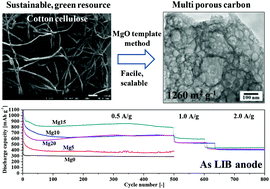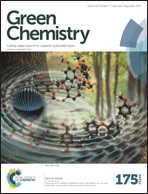Cotton derived porous carbon via an MgO template method for high performance lithium ion battery anodes†
Abstract
Porous carbon has received great attention for electrochemical energy storage devices. In this study, we proposed a novel and scalable method to fabricate porous carbon, which contained macro and mesopores, from sustainable biomass raw material of cotton cellulose. A MgO template, which acted as a pore creator, was incorporated into the cellulose-derived carbon by absorbing a Mg(NO3)2 solution into cellulose fibers with subsequent drying and carbonization processes. After removing the MgO template by acid leaching, porous carbon was produced with a specific surface area as high as 1260 m2 g−1. The sample showed attractive electrochemical performances as the anode material for Li ion batteries (LIBs). The carbon anode delivered a high reversible capacity of 793 mA h g−1 at a current density of 0.5 A g−1 after 500 cycles. The carbon anode also showed a high-rate capability and a capacity of 355 mA h g−1 can be obtained at a current density of 4 A g−1. A widespread comparison with the literature also showed that the cotton-derived porous carbon was among the most promising carbon-based anodes for LIBs.


 Please wait while we load your content...
Please wait while we load your content...